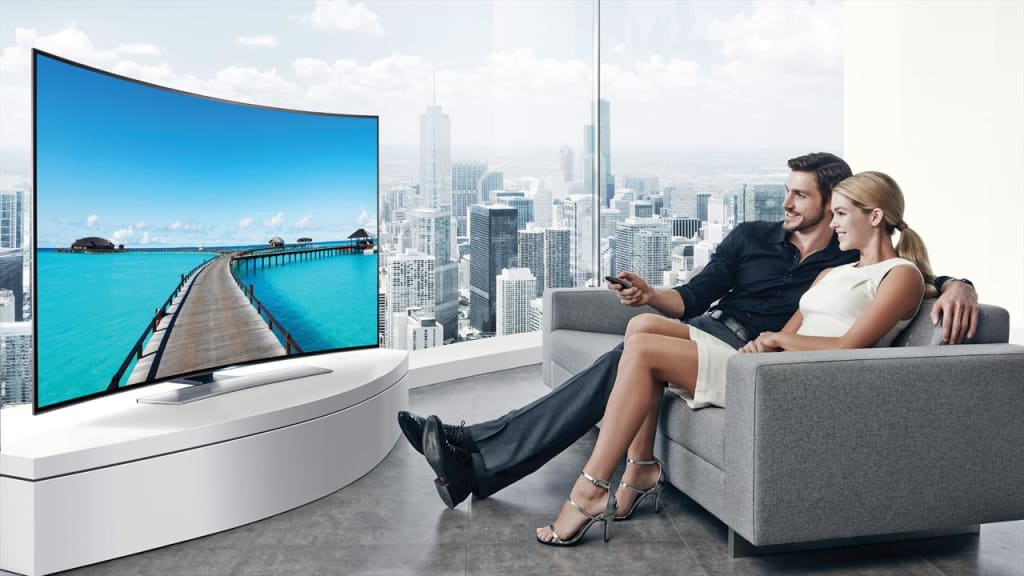A Crash Course on Curved Screens
We've all heard of them, but how did curved screens come into existence, and why should we buy them?

Curved TV screens are one of those novelties of the 21st century that not many people quite understand. When we thought normal screens were good enough; higher pixel density, higher dynamic range and larger size, things were changed drastically. The flat screen still exists, but now with a glowing new cousin – the curved monitor. Whilst I won’t be buying one any time soon, namely due to the fact that I can’t really find a spare $12,000 without selling one of my organs, there is no denying curved TVs will be the future ‘norm’ as manufacturing and purchasing prices eventually drop.
So, here’s a tiny bit of backstory on what a curved screen actually is. Curved screens were birthed in 2013 during the Consumer Electronics Show (CES) in Las Vegas by the Korean super-giant technology companies Samsung and LG, spearheading a truly innovative new-ish market, or at least an expansion of an already massive market, to introduce the consumer available curved screen TV. However, the story existed long before that; since the 1950s, curved screen projection displays actually existed, largely used for plays, government emergency departments and art exhibits, utilising a distorted slide visual to project an image as flat on a curved wall. Described as being “an immersive experience”, curved screens initially appealed to ‘serious’ users of monitors, such as professional gamers, movie critics or those using distance monitors for work. In fact, on that last point, professional gamers have long credited some of their most recent successes and most enjoyable moments to multiple curved monitor set-ups; of course, not the most practical or available option for the average consumer, but a cool reality for professional eSports in the future.
The screen works to maintain an optimal position of viewing for the user, directly along the central axis of the TV with the central point of the monitor at eye level for the user. If seated in any other position, such as many experience in a movie theater, the picture quality can become distorted, ranging from minor distortion and discoloration to major and severe distortion such as trapezoidal distortion. In fact, official examinations performed found that in a 65” curved screen compared to a 65” flat screen, from the same distance from the centre, offers 0.19 degrees of greater viewing angle. Not much, in fact less than 1%, but an improvement nonetheless. In addition to the questionably improved degree of viewing angle, manufacturers claim that the curved TVs even offer minimized glare from the effects of ambient light.
The History

The absolute earliest implementation of the technology was in 1974 with the invention of ‘Gyricon’ by Xerox PARC researcher Nicholas K. Sheridon. His new technology, partly inspired by the then-popular Etch A Sketch was the wrold’s first electronic paper display, answering the call for more flexible display devices. Sheridon said that he this was the first steps towards a “paperless” office environment, with dependence on emerging technologies rising faster than the demand for paper-sorters and other seemingly less-productive outputs. Whilst it did take a few decades for this envisioning to come true, it did eventually, arguably thanks to that special little creation almost 4 decades ago. This 4-decade old technology is at the very heart of all of today’s modern curved television screens.
Ignoring older projection technologies like those used in IMAX and earlier theatres, it is likely that development of the consumer TVs we know today began during the year of 2010, when Samsung first announced an interest in making flexible technologies from the back of the AMOLED announcements – by the 2011 Consumer Electronics Show, their initial prototype was introduced. On October 10 2013, the company’s longstanding vision became a consumer’s reality with the creation of the Samsung Galaxy Round, labelled as the world’s first curved smartphone which quickly became the largest internet trend around the world. Everyone was gripped, with theories about how iPhone could adopt this new technology, or the ambitious theories for wearable technology.
At CES 2013, the largest competition was delivered to LG’s 55-inch curved display television in a slap-to-the-face by every company; Samsung and LG still spearheading the competition as the most notable and holing the “better product” that we all search for. So confident in their new technologies were LG that they actually started taking orders for their newest curved screen at the event…for the beautifully meagre price of $12,000. Samsung trailed behind and promised that their product would be delivered by the second half of the year.
And then, finally, Apple stuck its butt into the competition, surprising critics with its speedy product turn-around. On December 10 2012, a mere two months after the first curved smartphone was announced, Apple patented “a method of forming a curved touch surface”, sparking absolute media frenzies on every corner of social media – and a bunch of fake iPhone concepts. Conspiracies of bendable iPads, curved iMacs and slanted iPhones flooded the internet, but as of yet, Apple have not announced anything further. At the moment, with Apple at least, the best we can get is the little curve in the glass at the edge of our iPhones or iWatch.
So, Is this the Future?

Whilst it is incredibly hard to prophesize the future of technology in today’s fast-moving world, where computers double in power every few years and new inventions show consumerism into over-drive every other year, we can tell one thing – curved screens are here to stay. Throughout the entirety of 2015, both Samsung and LG committed more investments into their curved TV screen technologies, a strong and clear indication that more innovations are yet to come. The curved TV screen market continues to grow, spewing out larger screens; 3D integration, ‘Smart’ features like internet connections, social media, Skype and Netflix and wider field-of-viewing features. At the same pace, the push for curved smartphones is taking shape with Samsung’s newest releases in the phone market, as well as a multi-manufacturing effort to release the newest and greatest wearable technologies that revolutionise the integration of humans with technology in a method a little bit smarter than the past efforts.
About the Creator
Benjamin Wareing
Journalist and photographer. News, opinions and politics are my forte. Futuristic dystopian is my kink.






Comments
There are no comments for this story
Be the first to respond and start the conversation.